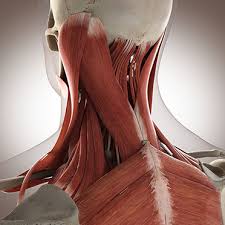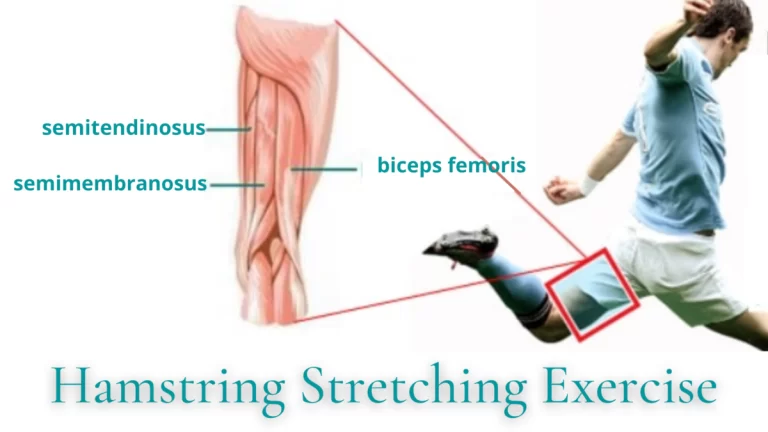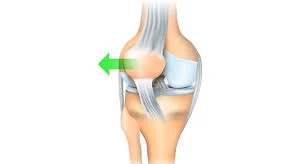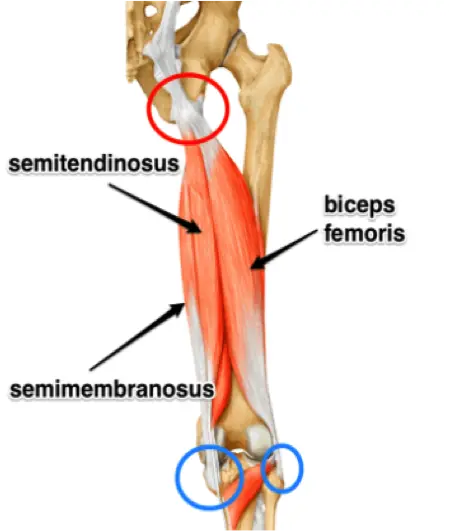Biceps Muscle Pain
Introduction
The biceps is one of the muscles in the anterior compartment of the arm. It runs along the length of the upper arm up to the elbow. As the muscle is involved in many day-to-day activities, it is common for people to suffer from biceps pain.
There are a variety of reasons why the biceps muscle might be tender or painful. This article covers the common reasons for biceps muscle pain and the variety of treatment options available for the same. Along with that this article also exerts the importance of physiotherapy and the physiotherapeutic assessment of biceps muscle pain.
Before diving into those topics, let us first do a recap on an overview of the biceps muscle.
Overview of Biceps Muscle
The Biceps Brachii is one of the muscles of the anterior compartment of the arm. It is better known as the biceps. This is the same, thick, fleshy muscle that bodybuilders or gymgoers flaunt while flexing their elbows.
The function of the Biceps Muscle is,
- Flexion of the forearm when the elbow is extended. This motion is repeatedly used by humans for every little thing.
- It is a strong supinator of the forearm along with the supinator muscle. This movement comes in great use when the screwing movements are done.
- The biceps muscle is responsible for flexing the forearm in the mid-prone position. This movement is made possible by 90-degree rotation of the muscle as it connects to the radius, one of the bones of the forearm.
- The biceps muscle is not the most powerful flexor of the forearm in other positions. Rather it works as a stabilizer and supports the stronger brachialis muscle while lifting or lowering weights.
- Biceps minimally aid in the shoulder flexion along with coracobrachialis and anterior deltoid muscles.
Causes of Biceps Muscle Pain
The discomfort felt in between the shoulder and elbow on the anterior aspect, is being labeled as bicep muscle pain. The pain can often travel to the back side of the arm and make it difficult to flex the elbow or upper back muscles.
Common signs and symptoms of bicep muscle pain include,
- Sharp pain in the anterior aspect of the arm
- Snapping or popping sounds during the movement
- Muscle cramps
- Bruising or discoloration of the skin
- Tenderness over or around the elbow
- Weakness of shoulder and elbow
- Rarely tingling and numbness in the arm
Common Causes of Biceps Muscle Pain
Biceps muscle pain might occur due to a variety of reasons. A few common of them and their basic signs and symptoms, and treatment option are listed below.
Bicep tendonitis
- It is an inflammation of the tendons due to repetitive movement or sudden overloading of the tendon.
- Is commonly seen in athletes or sports professionals like,
- Swimmers
- Baseball or softball players
- Volleyball players
- Tennis players
- Cricketers
Sign and Symptoms
- Painful shoulder or elbow movements
- Weakness of shoulder or elbow
- Tenderness over the anterior aspect of the arm or elbow
- A healthcare professional might inspect the arm and take a thorough history of a person’s lifestyle, hobbies, and profession.
- Next up is the observation of the area followed by palpation to check tenderness.
- If a tear is being speculated, diagnostic tests such as MRI might be suggested.
Treatment
- Protection, rest, icing, compression, and elevation (PRICE) protocol
- Over-the-counter painkillers
- Physiotherapy
- In case of severe injury, surgery
Biceps Tears
- In cases of chronic overuse or sudden force, tendon tears can occur.
- Around the shoulder, the tear is often due to jerky rotational movement of the shoulder or elbow.
- Around the elbow, the tear is often due to excessive loading of the muscle.
- The tear can either be partial or full
Signs and Symptoms
- Sudden, unbearable pain in the upper part of the arm or at the elbow
- Might be accompanied by a popping sound
- Inflammation along with tenderness over the area
- Bruise or discoloration of the skin
- Difficulty in supination of the forearm
- Weakness of shoulder and elbow
- “Popeye Muscle” appearance
Treatment
- Surgery in case of severe injury.
- Surgery to repair the long head tendon is safe, with a few common complications like infections.
- Surgery along with proper physiotherapy management can return the near to strength and function of the arm.
- It is very uncommon for the same tendon to be torn twice after surgery, provided proper strengthening protocol was followed.
- In case of minor tears, Protection, rest, icing, compression, and elevation (PRICE) protocol could be used followed by a period of strength and conditioning program.
Muscle bruise
- Bruising or discoloration of the skin can be another possible reason for biceps or arm pain.
- It happens when there occurs micro-injury to the blood vessels either due to blunt force or sudden overloading force on the muscle.
- The blood oozes out of the vessels, gets trapped in between the muscle and fascia, and is visible as bluish or reddish purplish discoloration of the skin.
- This can happen either due to contact sports injury or as a result of an act of violence or being in an accident.
Signs and Symptoms
- Painful to touch
- Discoloration of the skin
- Sometimes might be inflamed
Treatment
- Protection, rest, icing, compression, and elevation (PRICE) protocol initially.
- Depending upon the severity of the bruise it might take somewhere between 2 weeks to 2 months to heal.
- Painkillers and anti-inflammatory might be used if the condition is severe.
- If the pain keeps on increasing and the size of the bruise increases it is advised to consult a doctor to rule out any major blood loss.
Delayed Onset Muscle Soreness
- Delayed onset muscle soreness or DOMS happens when the muscles are overworked.
- This usually happens either while exercising a new regime or after a long time or doing too much at once.
- Delayed onset muscle soreness is quite common among professional sports persons, entertainers, heavy or manual workers, or any population in general.
- It is something everyone might have experienced at least once in life.
- It is termed delayed onset muscle soreness because the symptoms start to show up somewhere between 6-24 hours after a workout and typically last for a minimum of 48 hours.
Sign and Symptoms
- Pain and discomfort in the biceps
- Soreness in the arm
- Pain while performing bicep movements like carrying things or even during daily activities required to bend the elbow.
Treatment
- Resting the muscle followed by an ice pack is one of the very important remedies.
- Gently massaging the muscle for relaxation can also be beneficial, provided there is no inflammation.
- Over-the-counter drugs such as Advil or Ibuprofen can be used for pain or inflammation.
Physiotherapeutic Assessment of Biceps Muscle Pain
A detailed history is taken prior to physical examinations. This includes personal history such as hobbies, lifestyle, eating habits followed by their profession, and at last what they want the outcome to be or what their desired goal is from this visit.
A basic physiotherapy examination includes
- observing the skin for any bumps, discoloration, inflammation, or visible wound
- palpation of the area to check for any discomfort tiny bumps, tenderness over the area, etc.
- muscle strength testing to check the strength of the muscle. Is usually compared to that of the opposite nonaffected arm’s
- range of motion to assess how much and if any movement is restricted. Is usually done with a goniometer.
An obvious deformity to look at is the “Popeye sign” which happens as a result of the rupture of the long head tendon of the biceps
There are a few tests a physiotherapist might perform to confirm the diagnosis. Those include,
- Yergason’s test to check Biceps tendinitis
- Speeds test for superior labral tears or bicipital tendonitis
- Hooks test for distal biceps tendon rupture
- Biceps Squeeze test
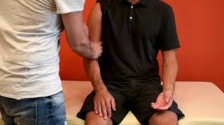
Physiotherapeutic Treatment of Biceps Muscle Pain
A good physiotherapy regime focuses on the reason why biceps pain or injury occurred in the first place. For athletes, it is more often than not due to improper postures, overloading of the muscles, or inadequate efficiency of the muscle to the task, it is being subjected to. Most of them can be corrected with proper stretching, pacing of activities, gradual strength and conditioning program followed by the incorporation of newly learned skills and efficiency effectively and ergonomically in everyday life.
For example in the case of tendinopathy, physiotherapy might start with intermittent rest followed by basic everyday movements. This can escalate by downloading the force on the muscle for a few weeks followed by gradual loading of the muscle progressively over weeks. In the end, the program might come to a cease by adding strength training as a part of a general body workout followed by appropriate warm-ups.
Stretching and strengthening programs are a vital part of any physio-therapeutic management. Initially, the therapists use electrical modalities such as ultrasound, iontophoresis, Transcutaneous electrical stimulation(TENS), interferential therapy (IFT), and low-level laser therapy, along with advanced methods such as dry needling, Cupping, and IASTM tool, deep friction massage, aquatic therapy, etc.
The physical therapist curates the plan as per the patient’s mechanism of injury, response to injury, objectives, and goals, and what outcome are they desiring for from this treatment. Factors such as their physiological wellbeing, environment, profession, psychological well-being, efficiency prior to the injury, strength in unaffected part, etc are all considered.
Before going forward with the rehabilitation, the therapists should always keep a few points in mind. Albeit the plan is for the patient, if they feel the person is not ready for a certain protocol, it is advisable to gently decline the patient with realistic and logical opinions. Another thing is the healing tissue must not be overloaded and very gradual loading should be done. Too much at a time might cause the healing tissue to be damaged which can further increase the healing process thus increasing the duration of rehabilitation.
There are certain guidelines a physiotherapist followed to determine which stage of healing the person is at and how to progress from there. These includes
- the duration of the injury,
- range of motion limitation if present
- the intensity of pain
- any inflammation is present or not
- what is the current strength of the muscle
- what was the prior efficiency of the muscle
- how well is the muscle responding to the loading
- Are there any negative effects of the program
- what is the age of the patient
- is the patient suffering from any co-morbidities
- are there multiple ailments involved
After resolving the pain with modalities and advanced techniques, next up in physiotherapy protocol is Exercise therapy. This generally should include:
- Re-establishing pain-free movements. The pain-free range can be restored with therapy such as Passive Range Of Motion exercises, which are progressed to Active-Assisted Range of Motion or AAROM exercises, ceased with active range of motion exercises. The mobilization techniques, either Matliand or Mulligan movement with mobilization might be used along with heat or cold therapy to enhance the movement and restore the flexibility and integrity of the tissue.
- Exercises to maintain a good scapulothoracic rhythm.
- Painful activities which might aggravate the patient’s condition such as above-the-head activities, taking the arm sideways, or unnecessary flexion of the elbow should be avoided in the early stages of rehabilitation as they can exacerbate symptoms and might enlist a fear of motion in the patient’s mind.
- The strengthening and conditioning program includes heavy gradual loading of the muscles with more emphasis on the scapular stabilizers, and rotator cuff, as they are synergist to the biceps muscle. This is followed by gradual progressive loading of the biceps tendon.
Physiotherapy Treatment
Physiotherapy is a part of Conservative management for various ailments leading to biceps muscle pain. The duration of the program depends upon the mechanism or cause of injury. For example, the physiotherapy management of long head of biceps muscle rupture takes about 4-6 weeks on average. with usually 3-4 sessions a week.
The exercise session typically consists of
- A period of pain management lasts for maybe 2 days to a week depending upon the severity of the condition and the intensity and pain tolerance level of the patient.
- This is followed by a range of motion exercises along with mobilization and a period of passive stretching techniques to improve muscle flexibility and motion.
- This is followed by a strength and conditioning program which depends on intensity depending on the person’s need, requirements, and profession.
- This is further carried on with the home program which generally includes exercises for flexion of elbow and forearm supination and pronation.
- Eccentric contraction exercises are added as this helps to strengthen the muscle for overhead activities
- People can go back to their daily routine in about 2 -6 weeks, all depending upon the severity, intensity, and duration of the ailment before starting the protocol.
- It takes about 6-8 weeks of the ROM exercise followed by strength training at least three times a week to go back to normal.
Stretching and Strengthening of Biceps Muscle
There are a variety of ways to stretch and strengthen the biceps muscle. A few of them with how to perform and the ideal repetitions are explained below.
Shoulder Extension With A Cane
For this stretching, you might require a rod or a cane or a bar.
How to perform shoulder extension with a cane?
- This can be performed either in sitting or standing. If standing, it is advisable to stand with feet hip-width apart and with knees soft.
- Use a cane or a rod or a bar to perform this stretching.
- Grab one end of the cane with one hand and the other end with the other hand, such that the arm to be stretched grabs the lower end of the rod or cane or bar.
- Now keep the arm at the lower end left straight from the elbow and use the other arm to push the downward arm backward with a cane.
- Hold the end position for 15-20 seconds and then back to the starting position.
- Repeat this motion 3-5 times or as necessary
- Now perform this by placing the upward hand downward and downward hand upward.
Biceps Stretch Sitting On A Chair

How to perform biceps stretch sitting on a chair?
- Take a sitting position on a chair.
- Place your palms on a chair in a flat position and your fingers are signaling backward.
- The palms are placed such that the forearm is supinated.
- Slowly bend backward until you feel a stretch in the front side of your arm.
- Hold the ending position where you felt stretched for 15-30 seconds.
- Repeat this stretching 3-5 times.
Bilateral Biceps Stretch
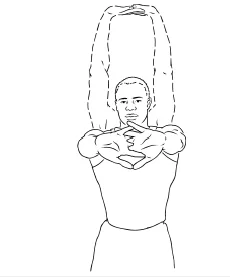
How to perform bilateral biceps stretch?
- This exercise is performed in a standing position.
- Move your arms straight with your fingers interlaced.
- Now, start raising your arms upwards in front of you until they reach the overhead position.
- Gently pull the arms upwards to the point of gentle stretch in the forearms and arm.
- Then hold the position where you feel the stretch for 15-30 seconds.
- Repeat this motion 3-5 times.
Biceps Stretch With Tubing
How to perform biceps stretch with tubing?
- To perform this exercise you need a tube or a flexible rod.
- Start with a standing position with arms forward and straight, so palms facing downward.
- Hold both ends of tubes in your hands and sweep up.
- Take an overhead position with tubing then behind back and elbow is straight.
- Hold that stretch for 15-30 seconds and repeat 3-5 times.
Biceps Stretch In Lying

How to perform biceps stretch in lying?
- Take a supine position.
- Put a folded towel under your arm, slightly above the elbow.
- The arms are slightly away from your body and the palms are facing upward.
- Now relax and lose your hands to falling with the gravity pull.
- You can feel stretch in front of your arm.
- Hold that stretch for 15-30 seconds and repeat 3-5 times.
Assisted Biceps Stretch Lying
How to do assisted biceps to stretch lying?
- Lay in a prone position with both hands behind your back with fingers interlaced.
- Now you need one partner to raise your hands upward until you feel stretched in front of your arm.
- Hold it for 15-30 seconds and repeat it 3-5 times.
Standing Biceps Stretching
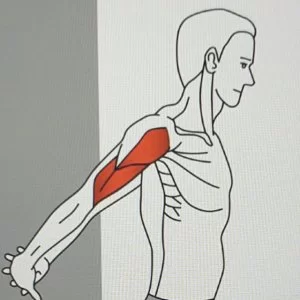
How to perform standing biceps stretching?
- Stand straight and interlace your hands behind your back at the base of your spine.
- Now slowly straighten your arms and turn your palms upwards.
- Then raise your arms upward as much as you can.
- When you feel the stretch or a gentle pull at the anterior aspect of the arm, stop and hold it for 15-30 seconds.
- Repeat 1 -3 times.
Seated Biceps Stretching
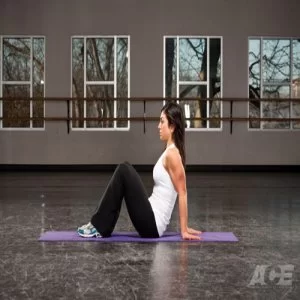
How to perform seated biceps stretching?
- Take a long sitting position on the floor.
- Then bend your knees, so your feet are flat on the floor in front of the hips, kind of like the crook sitting poison but with hand support.
- Now place your hands on the ground behind your back with fingers pointing away from the body.
- Equally distribute your body weight between your arms, feet, and buttocks.
- Slowly move your buttocks forward without moving your palms.
- If you feel stretched in front of your arms then hold the position for 15-30 seconds.
- Return to your beginning position and take a rest for a few seconds.
- Repeat it 3-5 times.
Doorway Biceps Stretching
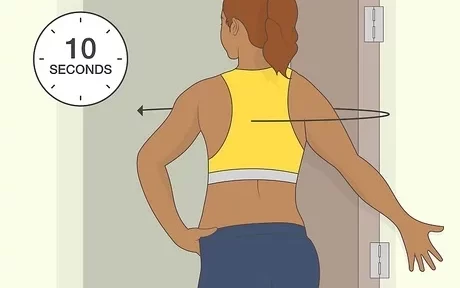
How to perform doorway biceps stretching?
- Stand in a doorway with your right hand holding the doorway at your waist level.
- Take a step forward with your right foot and bend the knee, then transfer your weight forward.
- You can feel a stretch in your right arm and shoulder while keeping your elbow slightly bending position.
- Hold it for 15 – 30 seconds and repeat on your left side.
- Repeat on both sides for a count of 3-5.
Wall Bicep Stretching
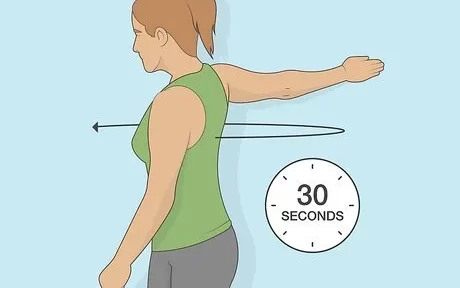
How to perform wall biceps stretching?
- Press your right palm against a wall or steady object.
- Slowly rotate your body away from a wall as shown above.
- You feel a stretch in your right arm, chest, and shoulder.
- Hold it for 30 seconds and repeat it on the left side.
Horizontal Arm Extensions
How to perform horizontal arm extensions?
- You can perform this stretch in a standing or sitting position. This stretch combines active motion with stretching.
- Extend or abduct your arms out to your side, so they are parallel to the ground.
- Now turn the thumbs downward so the palms are facing behind you.
- Hold it for 30 seconds. Now pulse the hands backward and forward for 30 seconds.
- Do it for 2-3 sets and gradually increase holding time.
Horizontal Hand Rotations
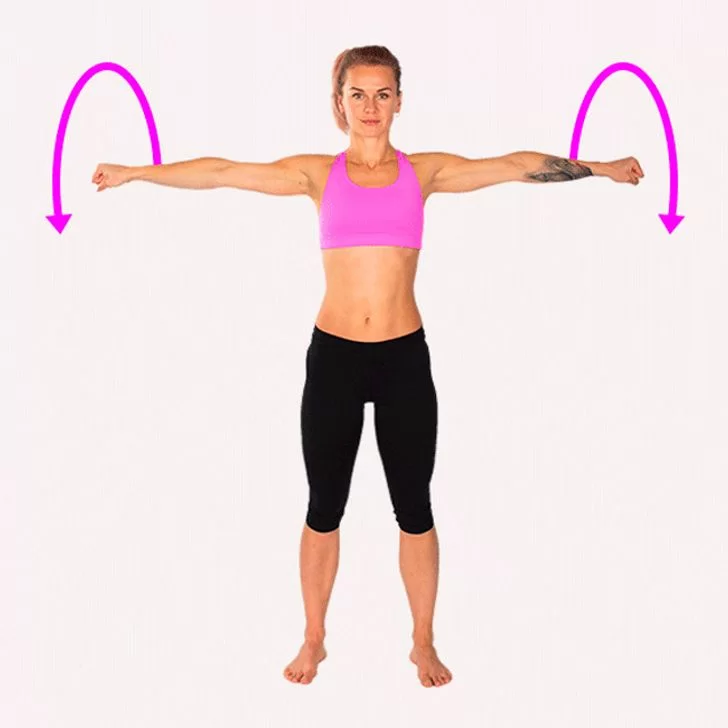
How to perform horizontal arm rotations?
- This stretching gently stretches your biceps muscle.
- Stand straight with your arms abducted forward up to 90 degrees, palms facing the floor.
- Now do the forward rotation of the shoulders by turning the thumbs downward.
- Then return to your starting position.
- Again rotate your shoulders, but this is a backward rotation by turning the thumbs upward.
- Return to the beginning position.
- Perform 2-3 sets for 1 minute.
There have different types of exercises to strengthen the biceps muscle. A few of them are explained below.
Biceps Curls
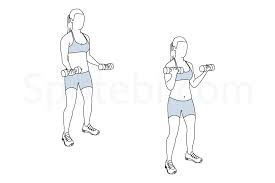
How to perform biceps curls?
- This is the most traditional exercise which targets your biceps muscle. For this, you need a pair of dumbbells.
- For this exercise, you have to stand with your feet hip-width apart, and abdominals engaged as you grab medium or heavy dumbbells in front of your thighs.
- It is advisable to start off with 1 or 2 kgs if you are new to this type of strength training.
- Your palms should be faced forward.
- Contract the biceps and flexed the elbows, curling the weights up towards your shoulders.
- Your elbows should be stationary and only bring the weight as much as you can lift without moving the elbows.
- Slowly lower down the dumbbell, keeping a slight flexion in the elbows at the bottom.
- Repeat for 2 to 3 sets of 10-15 repetitions.
Barbell Bicep Curls
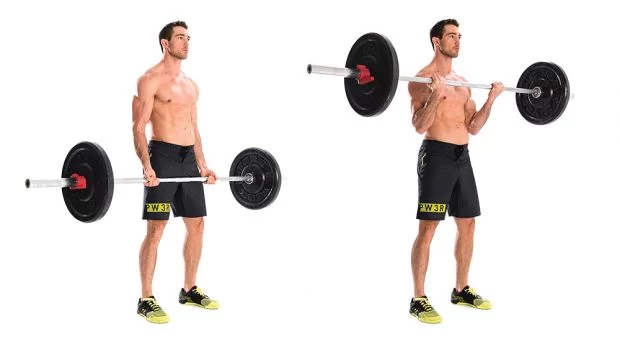
How to perform barbell biceps curls?
- The barbell bicep curl is a good way to work both heads of the biceps with more weight than we can typically handle with dumbbells.
- For this exercise, you have to stand with your feet hip-width apart, and abdominals engaged as you hold the barbell in front of the thighs, and the palm should be facing up.
- Contract the biceps and flex the elbows, curling the barbell up towards the shoulder.
- Your elbows should be stationary and only bring the barbell as much as you can lift without moving the elbows.
- Slowly lower the barbell, and keep a slight flexion in the elbows at the bottom.
- Repeat for 2-3 sets of 10-15 repetitions.
Incline Bicep Curls On The Ball Or Bench
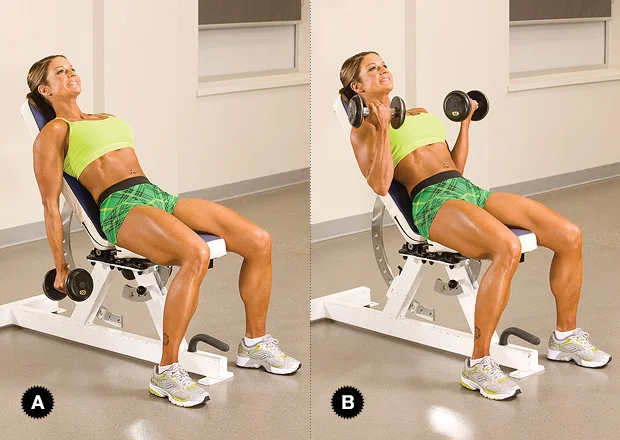
How to perform incline biceps curls on a ball or bench?
- There have not many ways to change a bicep curl, but one way to make the exercise a bit more challenging is to do them on an incline.
- You can do this on an incline bench or exercise ball.
- Because you are at an incline, you will have to work a bit harder against gravity, so you may want to use a low weight.
- For this exercise, you have to sit on the ball or a bench, as shown in the above image, with the barbell resting on your thighs.
- Slowly move your feet forward until you are at an incline with the ball supporting your back, weights hanging down with palms facing outward.
- Flex the elbows and bring the barbell towards the shoulder without swinging the arms.
- Now Lower the weight down, keeping a slight flexion in the elbow at the bottom of the movement.
- Repeat for 2-3 sets of 10-15 repetitions.
Bicep Curls With Alternating Arms
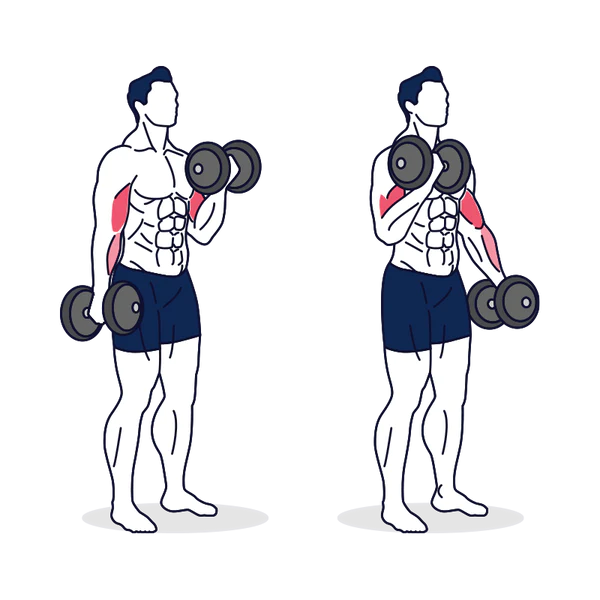
How to perform bicep curls with the alternating arms?
- If you are looking for a simple way to change your bicep exercises, try alternating Bicep Curls.
- By alternating the arms, you change the exercise just a bit and may be able to use heavier weights than you use in a regular curl.
- Because a single-arm gets a bit of a rest while the other one works, you may find heavier weights a better choice.
- For this exercise you have to Stand with hip-feet width apart, abdominals engaged as you grab medium or heavy dumbbells in front of your thighs.
- Your Palms should be facing forward. Contract the biceps and flexed the left elbow, curl the dumbbells up towards the shoulders, your elbow should be stationary.
- Lower the dumbbell, and keep slight flexion in the elbow o keep tension in the muscle.
- Repeat this movement with your right arm, and continue curling for alternating arm for 2 to 3 sets of 8 to 12 repetitions.
Preacher Curls On The Ball or Bench
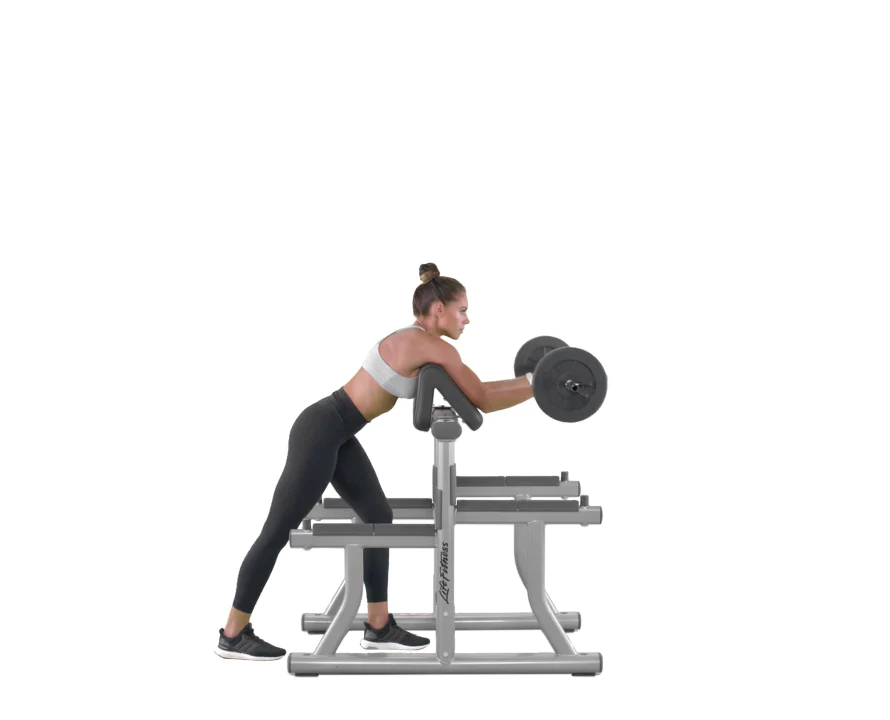
How to perform preacher curls on a ball or a bench?
- The preacher curl is just one variation of the basic bicep curl.
- By placing your arms at an angle, you challenge both heads of the biceps muscles so you may need to use low weight with this move.
- In this variation, a ball or a bench is used to create the angle but you can also do this movement on a preacher bench.
- You may want to skip this exercise if you have any elbow issues.
- For this exercise, you have to hold the dumbbells and kneel in front of the ball and drape yourself on the ball and both arms are parallel to one another.
- Slowly lower the weight until your arms are fully extended.
- Engage the biceps muscles to raise the weights until the forearms are vertical to the back of the upper arm. Repeat for 1 to 2 sets of 10 to 20 repetitions.
Hammer Curl
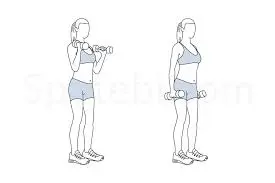
How to perform the hammer curls?
- Like the all-curl variation, the hammer curl also targets the biceps muscles. But in this, your hands are rotated, and the forearms also get a bit more attention in this exercise.
- Changing the hand position it can also make this exercise challenging differently, so you can do these in combination with regular curls or barbell curls to target the full range of the biceps and the forearms.
- For this exercise, you have to stand with feet hip-width apart, abdominals engaged as you hold a medium to heavyweight in front of the thighs. both palms face each other. Contract the biceps to curl the dumbbells towards the shoulder.
- Your elbows should be stationary and only bring the weight as much as you can lift without moving the elbows.
- Slowly lower down the weight, and keep slight flexion in the elbows at the bottom.
- Repeat for 2 to 3 sets of 10 to 16 repetitions.
Concentration Curls
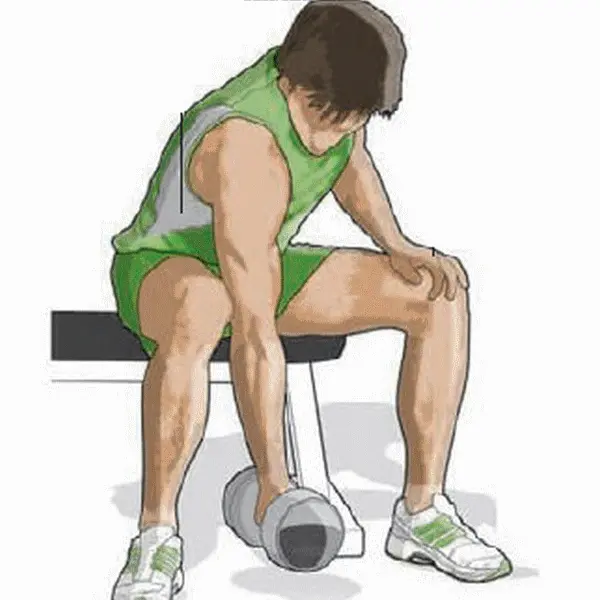
How perform the concentration curls?
- Its name implies the movement. you have to concentrate on your form.
- This is a great workout for the biceps to increase blood flow to the muscle.
- For this exercise, you have to take a sitting or kneeling position and grab the dumbbell in your left hand.
- Bend forward, your abdominals should be engaged, and prop the left elbow against the left thigh.
- Contract the biceps muscle and curl the hands towards the shoulder without moving the elbows.
- You do not have to touch your shoulder.
- Lower the weight down and repeat for 2 to 3 sets of 10 to 15 repetitions on both sides.
Barbell Concentration Curl
How to perform the barbell concentration curl?
- In this, you are in a bent-over position, which shortens the range of motion and requires the abdominals and back to work harder to keep you stable.
- Because the range of motion is short, you will feel this exercise, so start with a lighter weight if you are new to this exercise.
- For this exercise, you have to sit on a chair or on a bench and hold a medium-size barbell with hands about shoulder-width apart.
- Now bend over, back should be flat and abdominals engaged, and prop the elbows on the inside of the thighs. start the movement with arms extended, the barbell hanging down to mid-shin.
- Contract the biceps to curl the weight up as high as you can (in this shorter range of motion is used) now lower the weight down, and keep slight flexion in the elbows on the inside of the thighs.
- Repeat for 2 to3 sets of 10 to 20 repetitions. The back should be straight throughout the movement.
One-Arm Preacher Curl On The Ball
How to perform a one-arm preacher curl on a ball?
- The preacher curl is the best exercise for isolating the biceps muscles.
- By resting your arm on a preacher bench or exercise ball, you take the momentum out of the movement, allowing the biceps to do all the work.
- If using a ball for this exercise, then practice with your positioning until you feel supported and able to do the exercise in good form throughout the exercise then only use it.
- Place a medium to heavyweight on the ground in front of you and roll forward on the ball so that the trunk is supported.
- Extend the left arm over the ball and hold the dumbbell, keeping the back of the arm resting against the ball.
- Take care not to hyper-extend the elbow here.
- Make sure you are forward enough on the ball that you can safely reach the dumbbell. Contract the biceps to curl the dumbbell up toward the shoulder, your wrist should be straight.
- Lower back down, without locking the elbow joint, and repeat for 2-3 sets of 10-16 repetitions on each side.
Cable Curl

How to perform the cable curl?
- For this exercise, you need a cable curl machine for the exercise instead of dumbbells and kettlebells.
- In this variation, there have many different hand positions to build your biceps strong.
- When cable handles are used, you adjust the standard underhand grip, overhand grip, or hammer grip.
- There are also straight bar and EZ bar cable attachments in this machine.
- The angle of the curl will be adjustable in this.
- A high cable curl position will work your front deltoids and upper pectorals as the upper arm will be held parallel to the floor with an external rotation of the shoulder joint to contract the biceps brachii muscle during the elbow flexion.
- On another side, a low cable curl grip needs for slight pinch in your upper back to retract shoulder blades and keep the chest open during the curl.
- It is advisable to perform this exercise only under the guidance of your gym trainer or sports therapist or physiotherapist to ensure you are working the right group of muscles.
Zottman Curl

How to perform the zottman curl?
- This variation of curl is mostly done with dumbbells, kettlebells, or bands.
- This variation requires rotation from the wrist and forearm.
- You have to start this with a standard curl-like palm-up, with your forearm supinated and hanging by your sides.
- When you bend the elbow and bring the weight toward the shoulder, your palms rotate away, your forearm is pronated, and contract arm muscles.
- When your arm is straight, you have to rotate your wrists back to the supinated position for the next repetitions.
- For this variation, it is always advisable to use a lighter weight and to perform it initially under the guidance of a professional.
When to Seek Professional Help?
It is advisable to seek professional help or contact a medical practitioner in case of,
- Increasing pain
- Increasing the size of the bruise
- Snapping sound during the injury
- No feeling in arm or elbow
- Tingling or numbness in the arm or elbow
- Radiating pain
- Chest pain followed by arm pain
- Dislocated or broken bone
- Bulging muscle
- Unbearable pain
- Unable to flex the elbow
- Excessive pain while moving the arm or elbow
- Weakness in the arm or elbow
- Sudden loss of muscle strength
Disclaimer
The information in this article is only for educational purposes. Please do not consider this as a substitute for medical advice in any way or form. In case of doubts, kindly contact the health care practitioner for further clarification.
The exercises mentioned are that fit for normal otherwise healthy individuals. It is always advised to connect with physiotherapists, fitness trainers, or sports therapists before starting any new exercise or regime. This is to make sure your body is ready for that particular exercise, would it be able to handle those loads, and the biggest of all, are you performing this exercise correctly, is your posture good, and what other precautions should be taken which is unique to you only.
Similarly, while performing the stretches, make sure your body is relaxed as possible. You only want o stretch the muscle to the point of a slight pull. Caution must be taken to not to overstretch the muscle as that decreases its integrity and strength.


